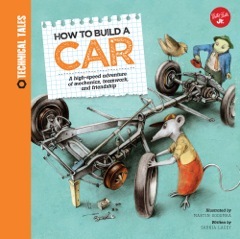HOW TO BUILD A CAR - Steve Purdy Book Review
 |
HOW TO BUILD A CAR
A high-speed adventure of mechanics, teamwork and friendship
Written By Saskia Lacey
Illustrated By Martin Sodomka
Published by Walter Foster, Jr., an imprint of Quarto Publishing Group,
USA
$14.95 at www.QuartoKnows.com and wherever books are sold
The Auto Channel
Michigan Bureau
There is no better gift for a kid than a real, hardbound, colorful, intriguing book. I can still do the majority of my holiday shopping in a good book store. Here is one you can consider for your youngsters – boys or girls, perhaps 5- to 10-years-old, whether or not they are interested in cars – called How to Build a Car: A high-speed adventure of mechanics, teamwork and friendship.
The rich illustrations will first catch their eye and pique their interest in this action-packed, purposeful book. It is all about three seemingly mismatched friends with very different but complimentary talents who conspire to build a cool car of their own design. Martin Sodomka, a Czech graphic designer and illustrator, uses modestly detailed depictions of the components that make up a car with rather abstract, unusual characters who plan the processes and put the parts all together. Artist Sodoma does a masterful job of making the mechanical pieces fun and interesting to look at as well as descriptive enough for youngsters to understand what they are seeing. The art is both unusual and attractive.
Author Saskia Lacey, teacher and children’s author, creates a story about three erstwhile friends - Eli the idea-guy mouse, Phoebe the smart and detail-oriented sparrow and Hank the parts guy and junkyard frog – who decide to build a car nearly from scratch just for the pure fun of it. As the story develops we find that each character has deficits that the others mitigate. With just enough conflict to make the story lively, the friends eventually build a beautiful, 1960s-style 2+2 roadster that they name Elephank because it is so big. As the story develops the characters must cooperate, think things through and combine their talents to complete the project – all great lessons for kids to learn.
The team of car builders began by building up the chassis starting with the basic frame members, adding suspension, drive train components, brakes and tires. Then they put together the 3-cylinder engine, adding the transmission and the rest of the driveline. Finally they fashion the body using wooden bucks for shaping the metal. Each stage along the way gets just enough illustrations and text to describe the process without becoming so esoteric as to loose the interest of the reader. Parts and pieces are annotated fairly accurately but in a way that younger readers can skim over if it becomes too much detail.
As a car guy I found a few details less than credible, but only one really stands out. As they are building the engine and describing the four-stroke engine cycle of an internal combustion engine the sidebar says, “The engine’s carburetor uses electricity to ignite the fuel.” Wrong. Spark plugs ignite fuel that the carb meters before sending it to the cylinders. The book’s credits list a “resident gear head” who we assume was the technical consultant. I guess he just missed that one. Otherwise, the technical aspects of the book are quite accurate.
In the end the roadster gets completed because the three friends cooperate at each level of construction. The book offers a wonderful template on the ways individuals with divergent skills and mismatched personalities can get a creative project done and have fun doing it.
ęSteve Purdy, Shunpiker Productions, All Rights Reserved


